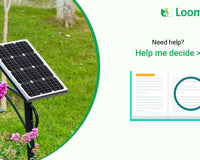The power production of solar panels on a cloudy day is significantly lower compared to a sunny day. The exact amount of power generated can vary depending on several factors, including the thickness of cloud cover, the type and efficiency of the solar panels, and the system's orientation.
On average, a solar panel might produce around 10-25% of its rated capacity on a cloudy day. Thick cloud cover can significantly reduce the amount of sunlight reaching the solar panels, leading to lower power generation.
For this in a solution, Loom Solar has developed a “Monocrystalline solar panel” are made of A grade mono perk cells and ultra cleared tempered glasses that does not break easily and gives 20-25% higher efficiency even in low light and cloudy weather. This panels comes with a 25-year warranty.
Monocrystalline PERC solar panels generally have higher efficiency and better performance in low light conditions compared to other types of solar panels. While they can still generate power on cloudy days, their output will be reduced compared to sunny conditions.
Keep in mind that even on cloudy days, solar panels can still contribute to your overall energy production and help offset some of your electricity needs. Additionally, if you have a off grid solar system with battery storage, any excess energy generated on sunny days can be stored and used during periods of low solar radiation, including cloudy days.
Note
Consulting with solar energy experts can help make an informed decision based on the specific circumstances. This can help ensure a more consistent power supply for your home.













2 comments
ALOKNATh markam
Solar lagwana hai
Ashish Kevat
Mujhe v lagbana hai